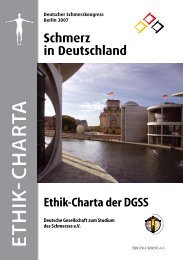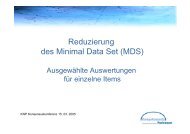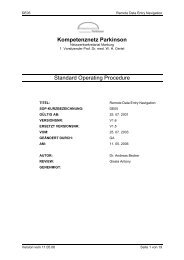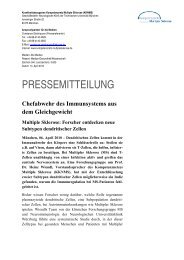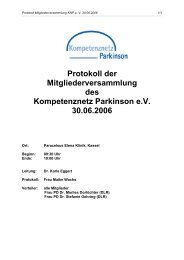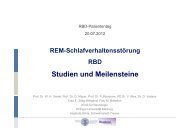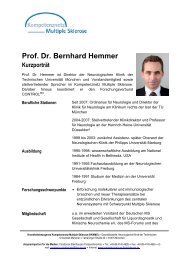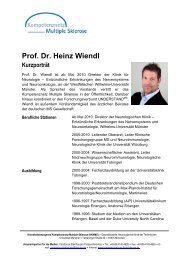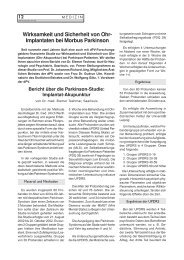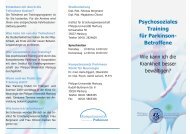Pathophysiology of Migraine - Kompetenznetz Parkinson
Pathophysiology of Migraine - Kompetenznetz Parkinson
Pathophysiology of Migraine - Kompetenznetz Parkinson
You also want an ePaper? Increase the reach of your titles
YUMPU automatically turns print PDFs into web optimized ePapers that Google loves.
122 SEMINARS IN NEUROLOGY/VOLUME 30, NUMBER 2 2010<br />
Table 1 Genetic Sites Proposed to Be Important in the Common Forms <strong>of</strong> <strong>Migraine</strong><br />
Chromosome/Locus Gene/Protein <strong>Migraine</strong> Type Reference<br />
1p13.3 Glutathione S-Transferase (GST) MO<br />
1 p36 MTHF-R MA<br />
4 q24<br />
? MA & MO<br />
4 q21<br />
4q31.2 Endothelin type A (ETA-231 A/G) Not specified<br />
6 p12–21 ? MA MO<br />
6p21.3 Tumor necrosis factor a (TNFa) Not specified<br />
6p21.3 HLA-DRB1 MO<br />
6q25.1 Estrogen receptor 1 (ESR1) MA & MO<br />
6q25.1 Estrogen receptor 1 (ESR1) Not specified Females only<br />
9q34 Dopamine b-hydroxylase (DBH) Not specified<br />
11 q24 ? MA<br />
11 p15 DRD4 MO<br />
11q22–23 Progesterone receptor (PGR) MA & MO<br />
11q23 DRD2 Allele 1 TG dinucleotide non-coding MO<br />
11q23 Dopamine D2 (DRD2) NcoI MA<br />
14 q21–22 ? MO<br />
17q11.1-q12 Human serotonin transporter (SLC6A4) MA & MO<br />
17q23 Angiotensin converting enzyme (ACE) MO<br />
19p13.3/2 Insulin receptor INSR Not specified<br />
22q11.2 Catechol-O-methyltransferase (COMT) not specified<br />
X q24–28 ? MO<br />
MA, migraine with aura; MO, migraine without aura.<br />
a key factor in ongoing and future migraine pathophysiologic<br />
research.<br />
INVESTIGATIONS OF MIGRAINE<br />
PATHOPHYSIOLOGY<br />
Investigations <strong>of</strong> migraine pathophysiology can be divided<br />
into three groups based on the cascade <strong>of</strong> clinical<br />
events that occur during an acute migraine attack. These<br />
groups include (1) those investigations related to the<br />
brain events initiating a migraine attack; (2) those<br />
examining the mechanisms <strong>of</strong> activation and transmission<br />
within trigeminal afferent neurons, and (3) those<br />
focused on the modulation <strong>of</strong> and possible consequences<br />
<strong>of</strong> recurrent nociception trigeminal input within the<br />
central nervous system.<br />
Investigations <strong>of</strong> <strong>Migraine</strong> Attack Initiation<br />
The factors that render an individual susceptible to<br />
attack initiation arguably constitute the essential abnormality<br />
<strong>of</strong> migraine. Efforts to find a single mechanism to<br />
explain migraine are ongoing and putative sites have<br />
been suggested from the calcium channel to the rostral<br />
brainstem. However, thus far, no single convincing allencompassing<br />
mechanism has been identified. Over the<br />
past two decades, research focusing on migraine initiation<br />
has centered on (1) changes in cortical blood flow<br />
and in activation patterns during attacks <strong>of</strong> migraine<br />
with aura, (2) altered activation thresholds within the<br />
cerebral cortex, and (3) changes that occur in the<br />
activation pattern in brainstem nuclei in migraine attacks<br />
without aura.<br />
INVESTIGATIONS OF THE MIGRAINE AURA<br />
The aura consists <strong>of</strong> focal neurologic symptoms that<br />
herald the acute migraine attack and occurs in up to<br />
25% <strong>of</strong> migraine sufferers. The aura has figured prominently<br />
in attempts to study and ultimately explain migraine<br />
pathophysiology. The vasogenic theory assumed<br />
that the aura represents the consequence <strong>of</strong> an initial<br />
vasoconstrictive phase <strong>of</strong> the migraine attack. 13 However,<br />
in the 1940s Lashley, after plotting progression <strong>of</strong> his own<br />
visual scotomata, proposed that aura was due to an<br />
abnormality which spread over his visual cortex at a rate<br />
<strong>of</strong> 3 to 5 mm per minute. 48 This migratory pattern would<br />
have been atypical for an ischemic phenomenon. Around<br />
the same time, Leao, a neurophysiologist, described an<br />
electrophysiologically measurable phenomenon that appeared<br />
and migrated over the cortex <strong>of</strong> experimental<br />
animals at a slow rate <strong>of</strong> 3 to 4 mm per minute after<br />
mechanical or chemical perturbations. 49 Although this<br />
phenomenon consisted <strong>of</strong> an excitatory phase followed by<br />
a phase <strong>of</strong> depressed activity, it has been termed cortical<br />
spreading depression. Based on the slow rate spread <strong>of</strong><br />
both phenomena and the movement across neurovascular<br />
boundaries in both, it has been proposed that the aura <strong>of</strong><br />
migraine is caused by a human analogue to cortical<br />
25<br />
26<br />
27,28<br />
29<br />
30<br />
31<br />
32<br />
33<br />
34<br />
35<br />
36<br />
37<br />
38<br />
39<br />
40,41<br />
42<br />
43<br />
44<br />
45<br />
46<br />
47<br />
Downloaded by: Universitätsbibliothek Marburg. Copyrighted material.



